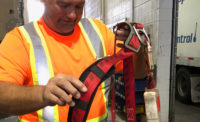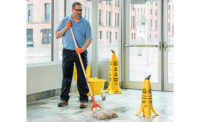In a warehouse, objects are often placed at towering heights that are hard to reach without using some type of equipment, such as a forklift or a man-aboard order picker. Workers are often in danger of being hit by objects falling from heights or by reaching and bending into shelving to get to a product. Improper handling of boxes, pallets, cartons and items can cause strain and injury to different parts of the body, especially the back.
Warehouse hazards, though, create more accidents because of the massive quantities of products of all different sizes, shapes and weights stored on shelves, floors and anyplace else someone can find a place to put a box, pallet or carton.
The top injury categories at a warehouse are:
Slips, trips, and falls
Each year, more than eight million Americans will be treated in emergency rooms due to an accidental fall. If items are stored haphazardly within the distribution center, such as sticking out too far from a shelf, or placed in the middle of an aisle, workers can easily injure themselves by tripping over or running into these items. Making sure floors are dry and slip-resistant can prevent slips, trips and falls.
There is additional risk when stepping into a rack to pick an item while picking on a man aboard order picker. Warehouses that use manual picking have to put a person up to those towering heights to retrieve picks that aren’t full pallets (which they would use a forklift for). Not only does that expose a picker to the over-exertions of bending and reaching into racks, they have to do it 20 feet off the ground. This is a recipe for disaster.
Ergonomic-related pains
Lifting and handling materials — Improper handling of boxes, pallets, cartons and items can cause strain and injury to different parts of the body, especially the back. Heavy, big objects should be placed in the “golden zone,” where workers do not have to bend, reach or lift above their shoulders or below their waists.
Overexertion injuries — These occur when workers lift items that are big and heavy for a long period of time, resulting in excessive physical effort. Injuries can occur to joints and ligaments. Also, in the warehouse workers walk to pick orders. The trip length between picks can be quite long, especially if the warehouse is not organized properly. Properly planned pick paths, SKU rationalization and appropriate slotting of SKUs can help to cut down the length the worker must travel to fill orders.
Material handling incidents
Falling objects — Items not stored properly can fall and injure someone. If the storage racks do not have end-caps, items can just slide right out onto the floor causing injury.
Forklifts — Most accidents occur in a warehouse at/with the docks, forklifts, conveyors, storage units and manual lifting/handling. Forklifts can overturn or they can be overloaded, subjecting materials to falling off. Accidents between forklifts or between a forklift and another surface can cause serious injury. Statistics show that one in tne forklifts are involved in an accident each year. Operators need to check hydraulic levels, tire pressure, engines, controls, steering and brakes each day to make sure all are working properly. Forklift work platforms can minimize risks for those doing overhead tasks.
Ergonomics and productivity
Ergonomics is important in the warehouse for safety as well as productivity, but productivity does not necessarily mean harder work. It often means less touches and interactions – and to handle items correctly to reduce the risk of injury. Workstations should be organized with tools, parts and components close by in a neat orderly environment.
Ergonomics means designing the job to fit the worker to help reduce muscle fatigue and potential injury. Working in the golden zone, which is the area nearest to the core of the body between the shoulders and knees, is the target area for ergonomics. Operating in this zone, items should be presented to workers in such a way that they rarely need to lift their arms above their shoulders or reach below their waists.
Reducing injuries increases productivity, which is important in today’s consumer-driven marketplace that demands distribution facilities operate as efficiently as possible.
Ergonomic equipment
A good ergonomics program can decrease risk of injury, reduce travel time for workers, and optimize space — driving significant improvements to the bottom line and a more efficient operation overall. Let’s look at ergonomic equipment that can be used to reduce injuries in the warehouse.
It is very common for workers to injure themselves by reaching deep into a pallet rack in order to pick a case. If a case is stored on a pallet on the floor, they have to bend and reach, limiting their ability to properly lift the case and increasing their odds for injury. If the case is stored deep within the pallet rack, visibility and reach is compromised and further jeopardizes the worker’s safety when picking a case. Using pallet flow racks can ensure that the case is at the point of pick, and that workers do not have to climb into a pallet rack to reach them.
Tilted pick trays allow workers to get a better look at cases stored higher in the pallet rack, and allows them to pick that case without blindly reaching into the rack or scaling the beams. Equipment that allows the picker to slide products to the point of pick can also help workers avoid overexertion and injury.
Building a safety culture
Train employees on each piece of equipment — how to operate it and how to stay safe when using it.
Ask your workers to report if they see unsafe conditions or activities. Tell your workers you want to make sure they get home safely to their family, which is why you have established these procedures. Show them you care about their safety, and they will care about it too.
Regularly train employees, from new hires to long-timers. Keep reminding them of safety issues.
Make sure equipment is well-maintained, work spaces are clean and warehouse aisles are clear from clutter to keep people from tripping.
Encourage employees to be aware of their surroundings at all times and stay alert. Have them wear personal protection equipment when appropriate.



